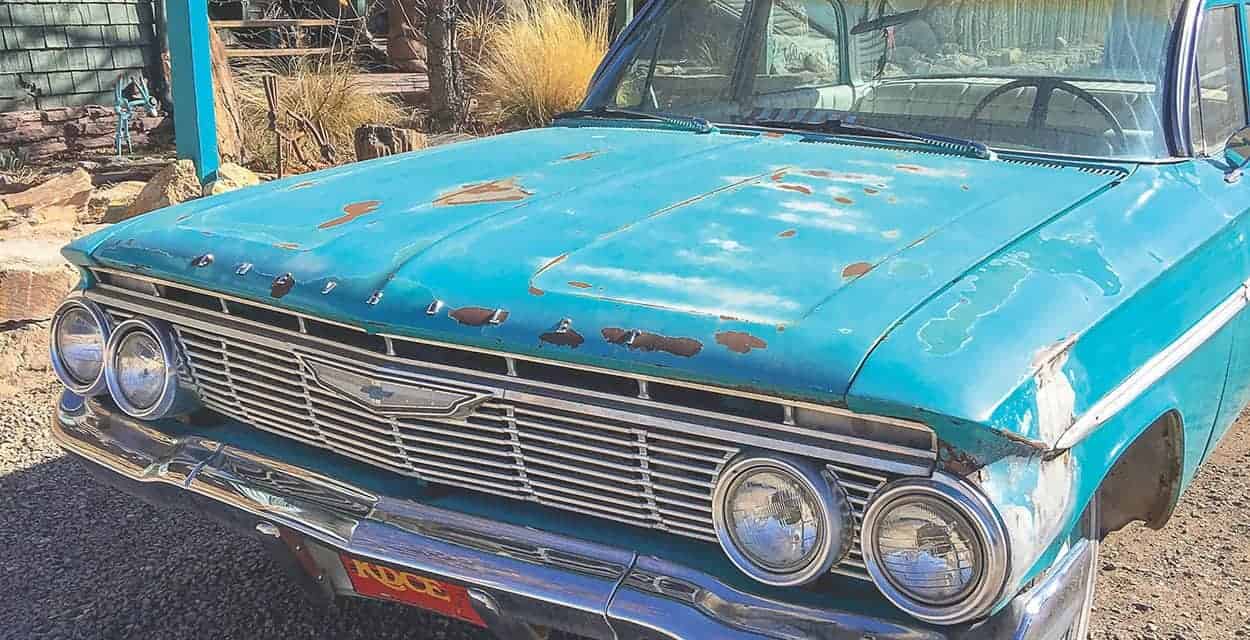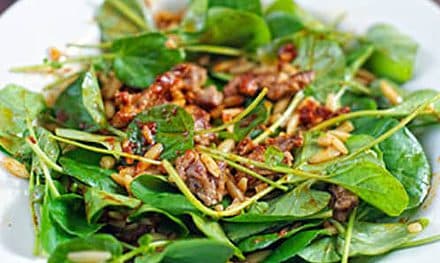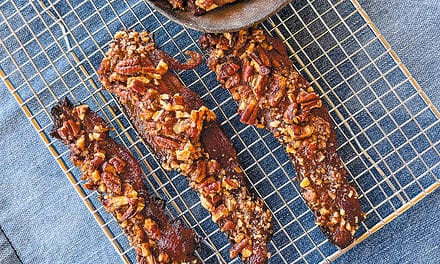By Michael J. Dax · Photos by Stephanie Cameron

Chevrolet relic in Madrid
In mid-February my view of the Sangre de Cristo mountains revealed a mix of brown and green, the full effect of northern New Mexico’s non-winter in plain sight. So instead of heading up to Ski Santa Fe for the sweet powder turns that I relegated to my dreams, I decided to turn my attention south along NM 14. Better known as the Turquoise Trail, the two-lane road runs from Santa Fe’s Southside to Interstate 40 in Albuquerque’s East Mountains, capturing a healthy dose of New Mexico’s history and culture along the way.
While Madrid, the quirky centerpiece of the Turquoise Trail, is well-regarded throughout New Mexico as a funky art community and frequent destination for visiting relatives, on this trip, I was committed to seeing the Trail’s lesser-known attractions, highlights, and pit-stops.
With blue sky and unseasonably warm temperatures to ensure smooth sailing, my girlfriend Sullivan, our cattle dog mix Sadie, and I cruised past the flatlands just beyond the city limits supporting Santa Fe Brewing Company, the main office for the Santa Fe National Forest, and the state penitentiary. Indicating our first stop for the day, the small cluster of buildings known as San Marcos appeared just as ripples in the form of volcanic hills and arroyos pockmarked by twisted juniper begin to define the landscape.
A local favorite for more than thirty years, the San Marcos Café and Feed Store oozes the kind of rustic cachet that makes Santa Fe’s hinterlands worth exploring. Originally just a livestock feed store, the low-ceilinged, sprawling adobe building quickly transports diners back in time. While many Santa Fe establishments strive for this pastoral aesthetic, the café’s rough-hewn construction, handsome wood stove, and homey furnishings suggest its authenticity and help comfort diners.

Clockwise: Wagyu beef pastrami with roasted peppers and grilled onions at the Blackbird Saloon in Los Cerrillos; grilled elk and bison smokies with shishito peppers at the Black Bird Saloon; outside the Black Bird Saloon.
If that’s not enough, the breakfast menu features old classics with a New Mexico twist. Sullivan ordered one of their specialties, a cinnamon roll, which the menu claims to be “the traditional start to your meal.” Without some help, it would be the end of most people’s meals as well. The expansive roll assumed most of the small plate upon which it was served and fully lived up to its reputation. I ordered the biscuits and gravy, another dish not intended for the faint of heart. Whereas most biscuits and gravy would likely be described as gravy poured over biscuits, my breakfast would have been more aptly characterized as biscuits submerged in gravy.
Semantics aside, we gobbled down our breakfasts, and by the time we finished, we were more than ready to walk off our meal at the next stop—Cerrillos Hills State Park (five-dollar entry fee). Located just north of the town of Los Cerrillos, the small state park boasts five miles of hiking and biking trails that weave around its namesake features as well as defunct turquoise, copper, and manganese mines. The trails provide fantastic views of the Ortiz and Sandia Mountains to the south and the Jemez Mountains to the west.
The Jane Calvin Sanchez Trail merits a mention, as the hike includes interpretive signs providing historical information about the individual mining claims that dot the trail, as well as a broader history of mining in Los Cerrillos and Madrid at the turn of the twentieth century. To add another element to the relatively short walk, hikers can pick up a crossword puzzle at the trailhead and follow the interpretive displays to answer each clue as they walk the mile-long trail.

Top left, clockwise: Antique piano at the Black Bird Saloon; proprietors of the saloon, Patrick and Kelly Torres, leaning on the original bar; relics galore at Los Cerrillos Turquoise Mining Museum.
While far from New Mexico’s most stunning scenery, the small park provided a welcomed opportunity for all of us, especially Sadie, to stretch our legs, and a pleasant respite from what would prove to be a demanding culinary tour. As an added bonus, we watched a young coyote quietly tiptoe along a low ridge above us.
After our hike, we returned to the small town of Los Cerrillos, where little seems to have changed since Young Guns wrapped up shooting over thirty years ago. Other than its attractive cathedral, dirt roads and hunched adobe homes dominate the town’s three-by-three block matrix, making it easy to see why Hollywood producers would tap it for an 1880s cattle-town set piece. With history on our minds, the next logical stop was the Casa Grande Trading Post and Cerrillos Turquoise Mining Museum located, appropriately, at the end of town.
If character is key to San Marcos Café’s cultural currency, then Casa Grande upped the ante. The first room of the similarly low-ceilinged building was packed with turquoise jewelry and crafts, many of which are made from owners Todd and Patricia Brown’s Little Chalchihuitl mining claim in the Cerrillos Hills. I’ve recently developed an affinity for bolo ties and couldn’t help but add another to my collection. Continuing into the second room, visitors are greeted by a stockpile of unfinished semi-precious stones—everything from Cerrillos turquoise to jet to variscite mined from another claim worked by the Browns.
In the following room, through the swinging saloon-style doors, is the Cerrillos Turquoise Mining Museum, a semi-organized treasure trove of mostly local artifacts from the turn of the century, when more than one thousand mining claims were active in the region. Artifacts range from items such as shovels, picks, sluice boxes, wooden barrels, and stoves to pots and pans, glass bottles, and even cardboard cutouts of Smokey Bear, John Wayne, and Kiefer Sutherland. A cursory pass through the museum easily justifies the two-dollar entry fee, but a more detailed examination is sure to reveal a few diamonds in the rough.
Los Cerrillos boasted twenty-six saloons at its peak in the late 1800s, but today, there are only two options, Mary’s Bar and the Black Bird Saloon, which opened in 2016 and occupies a building built in 1885. Black Bird has maintained the saloon’s minimalist, old-timey feel, replete with a restored wooden bar, swinging doors, rustic furnishings, an antique piano, and deer antler tap handles for its draft beers. Its menu also features game meats such as wild boar, elk, and bison, with unique dishes like the Choctaw Kelly (wild boar Italian sausage, Dijon, and slaw on a brioche bun) and the Camp Fire Folk Lore (elk and bison smoked sausages with shishito peppers topped with Dijon and smoked sea salt).

Top left, clockwise: Cerrillos Opera House, built in 1881; Ale Republic in Cedar Crest; flight of Belgian-style beers at Ale Republic; Mary’s Bar, still in operation in Cerrillos.
After a quick lunch, we continued south toward Madrid. Although our focus was away from the Trail’s most popular stop, which we had visited many times before, we couldn’t resist taking the quarter-mile stroll through town, peering in some shops and soaking in the warm temperatures. Before resuming our journey, we made room for some ice cream from Jezebel Studio’s Soda Fountain. Sullivan had black cherry vanilla while I stuck with a personal favorite, cookies ‘n cream. The large deck shared by Jezebel and its neighboring galleries allowed us to leisurely savor our out-of-season treats as Sadie welcomed attention from passersby.
After that, we were back in the car, continuing south to the end of the trail. But before we could make our final stops in Cedar Crest, we felt compelled to make the small detour to the Singing Road, south of I-40 on the old Route 66. While not technically on the Turquoise Trail, this indelible piece of Americana was too tempting to pass-up.
Completed in 2014, the short stretch of eastbound highway has rumble strips that play “America the Beautiful” when cars pass over them at exactly forty-five mph. After driving west for a few miles, we pulled a u-turn to get in the eastbound lane, turned down the radio, and precisely set the cruise control. When we passed the sign reading “Musical road ahead,” we carefully tuned our ears to listen for the familiar notes, but despite our best efforts, we failed to recognize any discernible melody from the rumble strip’s gentle vibrations.
With more time to spare, we might have turned around for a second pass, but the afternoon was getting on and we were growing thirsty. Driving back north, we passed Greenside Café, a favorite breakfast stop for Turquoise Trail travelers starting their journeys from Albuquerque. But we were in the mood for something stronger, and navigated our way to Ale Republic, a small, unassuming brewery that opened in Cedar Crest in 2016.
Specializing in Belgian-style ales, Ale Republic combines the refined sensibilities of its niche craft stylings with the more proletarian aesthetic of its taproom to foster an atmosphere complementary to its semi-rural setting. I had the Diablo de Oro, a Belgian golden strong ale, ringing in at an impressive 9.2% ABV, and Sullivan opted for the Tokyo Black, a stout black ale brewed with green tea. Both beers brought plenty of flavor, and despite its high alcohol content, the Belgian Strong went down dangerously smoothly.

Top left, clockwise: Farm fresh eggs and homemade bread served up daily at Rancho Gallina; Mitch Ackerman and Leslie Moody; Rancho Gallina casita; barn that has been converted into the kitchen and breakfast room.
Following a couple beers each, we walked across the parking lot to Ribs BBQ, a locally owned restaurant that proudly describes itself as “a carnivore operation.” Having not fully digested our lunch (or breakfast, for that matter), Sullivan and I shared the half combination platter, which features ribs, smoked brisket, pulled pork, and hot links. Once our carnivore smorgasbord arrived, I had hardly rolled up my sleeves before Sullivan had plowed her way through three ribs—and for good reason! The well-flavored meat easily fell off the bone, and no sooner had I reached for my first rib than all that was left on our plate was a pile of bones. The platter’s other options more than met expectations, but the ribs, appropriately, stood out as the highlight.
Upon eating our monthly meat quota, we headed back home to Santa Fe, but for out-of-towners seeking to fully enmesh themselves in rural New Mexico or locals wanting a quick weekend getaway, Rancho Gallina, a self-described eco-retreat and bed and breakfast, serves up just such an experience. The following weekend I met Mitch Ackerman and Leslie Moody, the husband-wife team who began restoring the historic estate in 2012. Rancho Gallina opened in 2014 and is one of only two properties in New Mexico to earn TripAdvisor’s platinum Green Leader status.
According to Ackerman and Moody, the five-bedroom property, which now features rain catchment tanks to water their garden, solar power, geothermal heating, and a fruit orchard irrigated with greywater, offers an ideal setting for visitors looking for an alternative to the typical Santa Fe experience. “It’s not like Santa Fe at all,” claims Moody, citing their plentiful wildlife and unadulterated night skies.
After working high-stress jobs in Denver and Washington, DC, for more than twenty years, Moody and Ackerman admit they were burned out and looking for a change. They had been visiting Santa Fe for more than a decade, enjoying its culture and opportunities for outdoor recreation, so when the property became available, they were excited to create a space that would help others fall in love with northern New Mexico, too. “We built a place that’s like where we like to stay,” Moody says. “We cook like we like to eat.”
Ackerman and Moody will work with their guests to develop a menu that fits their wants and needs, but typical dishes include the Croque Gallina. This New Mexico twist on a French classic features a slice of Ackerman’s wild yeast sourdough topped with prosciutto, gruyère, mornay sauce, red chile, and an over easy egg from one of their chickens. Ackerman is also proud of his cocktails, such as the Santa Fe Sazerac, which employs mezcal to provide a hint of Mexican flavor.
As a former ranch and art colony turned eco-retreat, Rancho Gallina perfectly embodies the Turquoise Trail’s mixture of historic appeal and modern adaptation, bringing together northern New Mexico’s disparate charms. As Ackerman says, “For people who want something rural, a little more rustic and to be out in nature, you get the best of both worlds.”
www.turquoisetrail.org
www.ranchogallina.com
www.blackbirdsaloon.com
www.alerepublic.com
www.ribsbbq.com
Edible celebrates New Mexico's food culture, season by season. We believe that knowing where our food comes from is a powerful thing. With our high-quality, aesthetically pleasing and informative publication, we inspire readers to support and celebrate the growers, producers, chefs, beverage and food artisans, and other food professionals in our community.












